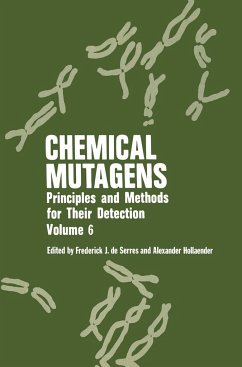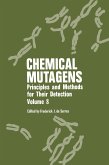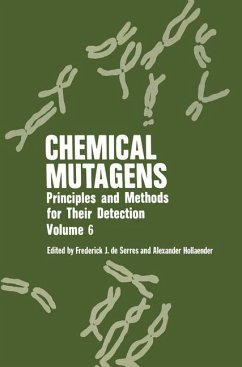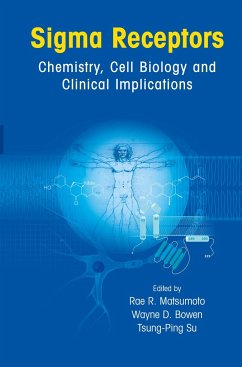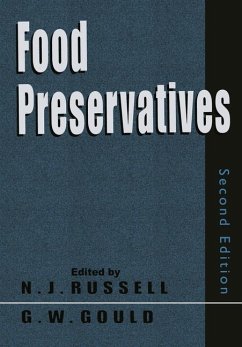Frederick J. De Serres, A. Hollaender
Chemical Mutagens
Principles and Methods for Their Detection Volume 6
Frederick J. De Serres, A. Hollaender
Chemical Mutagens
Principles and Methods for Their Detection Volume 6
- Gebundenes Buch
- Merkliste
- Auf die Merkliste
- Bewerten Bewerten
- Teilen
- Produkt teilen
- Produkterinnerung
- Produkterinnerung
- Weitere 8 Ausgaben:
- Gebundenes Buch
- Gebundenes Buch
- Broschiertes Buch
- Broschiertes Buch
- Broschiertes Buch
- eBook, PDF
- eBook, PDF
- eBook, PDF
In the rapidly developing field of environmental mutagenesis, the use of stand ardized protocols has permitted the evaluation of large numbers of chemicals for mutagenic and potential carcinogenic activity. In this sixth volume of Chemical Mutagens, the chapters by Perry, Williams, Rosenkranz and Leifer, Kada et al., Pienta, Tazima, Epler, and Rinkus and Legator provide a systematic listing of the chemicals that have been tested, bringing together both unpublished and previously published data. These chapters will serve as an important milestone by providing a convenient reference to…mehr
Andere Kunden interessierten sich auch für
![Chemical Mutagens Chemical Mutagens]() Frederick J. De SerresChemical Mutagens105,99 €
Frederick J. De SerresChemical Mutagens105,99 €![Chemical Mutagens Chemical Mutagens]() Frederick J. De SerresChemical Mutagens39,99 €
Frederick J. De SerresChemical Mutagens39,99 €![Chemical Mutagens Chemical Mutagens]() Frederick J. De SerresChemical Mutagens39,99 €
Frederick J. De SerresChemical Mutagens39,99 €![Chemical Mutagens Chemical Mutagens]() Frederick J. De SerresChemical Mutagens105,99 €
Frederick J. De SerresChemical Mutagens105,99 €![Chemical Mutagens Chemical Mutagens]() Frederick J. De SerresChemical Mutagens39,99 €
Frederick J. De SerresChemical Mutagens39,99 €![Sigma Receptors Sigma Receptors]() Sigma Receptors147,99 €
Sigma Receptors147,99 €![Food Preservatives Food Preservatives]() Food Preservatives116,99 €
Food Preservatives116,99 €-
-
-
In the rapidly developing field of environmental mutagenesis, the use of stand ardized protocols has permitted the evaluation of large numbers of chemicals for mutagenic and potential carcinogenic activity. In this sixth volume of Chemical Mutagens, the chapters by Perry, Williams, Rosenkranz and Leifer, Kada et al., Pienta, Tazima, Epler, and Rinkus and Legator provide a systematic listing of the chemicals that have been tested, bringing together both unpublished and previously published data. These chapters will serve as an important milestone by providing a convenient reference to tabulated test data with particular assay systems. Another important area of research is the modification of mutagenic activity. In the chapter by Sugimura and Nagao, factors that alter in vitro metabolic activation are discussed, whereas in the chapter by Maher and McCormick, the role of genetic heterogeneity is considered. Equally important is our need to obtain a better understanding of mutation-induction kinetics, and the mathematical analysis by Haynes and Eckardt provides an important step in this direction. An important new approach for the induction of specific locus mutations in human cells in culture is discussed in the chapter by Thilly and co-workers. We have also been concerned about the problems in the practical applica tion of various short-term tests in commerical testing laboratories. The prob lems emerging in the evaluation of potentially important new chemicals have been discussed in a chapter by Brusick et al.
Produktdetails
- Produktdetails
- Verlag: Springer / Springer US / Springer, Berlin
- Artikelnr. des Verlages: 978-0-306-40364-4
- 1980.
- Seitenzahl: 486
- Erscheinungstermin: 1. Mai 1980
- Englisch
- Gewicht: 892g
- ISBN-13: 9780306403644
- ISBN-10: 0306403641
- Artikelnr.: 27631136
- Verlag: Springer / Springer US / Springer, Berlin
- Artikelnr. des Verlages: 978-0-306-40364-4
- 1980.
- Seitenzahl: 486
- Erscheinungstermin: 1. Mai 1980
- Englisch
- Gewicht: 892g
- ISBN-13: 9780306403644
- ISBN-10: 0306403641
- Artikelnr.: 27631136
1 Chemical Mutagens and Sister-Chromatid Exchange.- 1. Introduction.- 2. Sister-Chromatid Exchange as a Measure of Chromosome Damage.- 3. Systems and Methods t2.- 4. Summary.- 5. References.- 2 Modification of Mutagenic Activity.- 1. Introduction. 41 2. Factors That Influence Metabolic Activation t2.- 3The Detection of Chemical Mutagens/Carcinogens by DNA Repair and Mutagenesis in Liver Cultures.- 1. Introduction.- 2. Types of Chemical Carcinogens.- 3. Metabolic Activation Capability of Liver.- 4. Liver Cultures.- 5. Carcinogen Metabolism in Liver Cultures.- 6. Hepatocyte Primary Culture/DNA Repair Assay.- 7. Mutagenesis of Rat Liver Epithelial Lines.- 8. Hepatocyte-Mediated Mutagenesis of Rat Liver Epithelial Lines.- 9. Discussion.- 10. References.- 4 Commercial Screening of Environmental Chemicals.- 1. Introduction.- 2. Transfer of Technology.- 3. Goals of Genetic Toxicology in Chemical Safety Evaluation.- 5. Legal Operation Requirements.- 6. Summary.- 7. References.- 5 Determining the DNA-Modifying Activity of Chemicals Using DNA-Polymerase-Deficient Escherichia coli.- 1. Introduction.- 2. Materials and Methods.- 3. Standard Assay.- 4. Modified Assay.- 5. Microsomal Activation.- 6. Results and Discussion.- 7. Comparison of the Pol A and Salmonella Assays.- 8. References.- 6 Screening of Environmental Chemical Mutagens by the Rec-Assay System with Bacillus subtilis.- 1. Introduction.- 2. Principles and Related Background of the Rec-Assay.- 3. Experimental Procedures.- 5. Rec-Assays on Chemical Carcinogens.- 7 Transformation of Syrian Hamster Embryo Cells by Diverse Chemicals and Correlation with Their Reported Carcinogenic and Mutagenic Activities.- 1. Introduction.- 2. Mammalian Cell Transformation Systems as Prescreens for Identifying Carcinogens in the Environment.- 3. Hamster Embryo Cell in Vitro Carcinogenesis Bioassay.- 4. Correlation of Transformation Response with Reported Carcinogenicity and Mutagenicity.- 5. Metabolic Activation.- 6. A Battery vs. a Tier of Short-Term Tests for Identifying Potentially Carcinogenic Chemicals.- 7. Conclusions.- 8. References.- 8 Chemical Mutagenesis in the Silkworm.- 1. Introduction.- 2. Methods for Mutation Detection in the Silkworm.- 3. Procedures for Administration of Chemicals.- 5. Mosaics and Delayed Mutagenesis.- 6. Exploitation of a Sensitive Test System with Oocytes.- 7. Screening of Environmental Mutagenic Compounds.- 8. Modification of Mutagenicity by Metabolic Activation.- 9. Conclusion.- 10. References.- 9 The Use of Short-Term Tests in the Isolation and Identification of Chemical Mutagens in Complex Mixtures.- 1. Introduction.- 2. Extraction Methodology.- 3. Mutagenesis Assay Methodology.- 10 Mathematical Analysis of Mutation-Induction Kinetics.- 1. Introduction.- 2. Definitions.- 3. Stochastic Description of Mutagenesis and Killing.- 4. Formal Dose-Response Patterns.- 5. The Linear Response Pattern (Lk,Lm).- 6. Nonlinear Response Patterns.- 7. Illustrative Calculations of Yield Curves.- 8. Relative Mutagenic Efficiency (RME).- 9. Stochastic Dependence of Mutation and Killing.- 10. Repair-Mediated Mutagenesis.- 11. Concluding Remarks.- 12. Summary.- 13. Appendix t2.- 11 Comparison of the Mutagenic Effect of Ultraviolet Radiation and Chemicals in Normal and DNA-RepairDeficient Human Cells in Culture.- 1. Introduction.- 2. Procedures.- 3. Evidence that Excision Repair Can Eliminate Potentially Cytotoxic and Mutagenic Lesions from DNA.- 12 Gene-Locus Mutation Assays in Diploid Human Lymphoblast Lines.- 1. Introduction.- 2. Exposure.- 4. Selection Systems.- 5. Experimental Observations.- 6. Discussion.- 7. References.- 13 The Need for Both in Vitro and in Vivo Systems in Mutagenicity Screening.- 1. Introduction.- 3. Correlations between Carcinogenicity and Mutagenicity in Salmonella.- 4. Construction of a Table of 465 Compounds with Known or Suspected Carcinogenic Activity (Table 4).- 5. Discussion of False Negatives from Table 4.- 6. Validation of Salmonella Testing as a Predictor of Carcinogenicity.- 7. Concluding Comments on Mutagenicity Testing.- 8. References.
1 Detection of Effects of Mutagens in Human Populations.
1. Introduction.
2. Monitoring Progeny for Evidence of Germ
Cell Mutations.
3. Detection of Gene Mutations in Somatic Cells.
4. Nongenetic Indicators of Mutagen Exposure.
5. Testing for Mutagenic Substances in Body Fluids.
6. Detection of Altered Sperm.
7. Summary.
8. References.
2 The Use of Intact Cellular Activation Systems in Genetic Toxicology Assays.
1. Introduction.
2. Mammalian Cell Mutagenesis.
3. Bacterial Mutagenesis.
4. Sister Chromatid Exchange and Chromosome Aberrations.
5. Cell
Mediated Transformation.
6. Cytotoxicity and Nucleic Acid Interactions.
7. Discussion.
8. Summary.
9. References.
3 The Mouse Spot Test As a Predictor of Heritable Genetic Damage and Other Endpoints.
1. Introduction.
2. Relation to Measures of Heritable Mutations.
3. Relation to Other Endpoints.
4. Summary.
5. References.
4 The Bone Marrow Micronucleus Assay: Rationale for a Revised Protocol.
1. Introduction.
2. Kinetics of Erythropoiesis.
3. Rationale for the Basic Aspects of the Protocol.
4. Protocol.
5. Statistical Analysis.
6. Conclusions.
7. References.
5 Relationships between the Chemical Structure and Mutagenic Activity of Monocyclic Aromatic Amines.
1. Introduction.
2. Bacterial Strains.
3. Experimental Methods.
4. Chemicals.
5. Mutagenicity Data and Their Interpretation.
6. Possible Pitfalls in Studies of Structure
Activity Relationships.
7. Conclusions.
8. References.
6 The Measurement of Recessive Lethal Mutations in the Mouse.
1. Introduction.
2. Haldane's Method of Detecting Lethals.
3. The Backcross Method of Detecting Lethals.
4. Irradiation Treatment of Male Germ Cells.
5. Irradiation Treatment of Female Germ Cells.
6. Chemical Mutagen Induction of RecessiveLethal Mutations.
7. Dominant Effects of Recessive Lethal Mutations.
8. Conclusions.
9. References.
7 Chemically Induced Changes in Sperm in Animals and Humans.
1. Introduction.
2. The F0 Mouse Sperm Head Morphology Assay.
3. The F1 Sperm Head Morphology Assay.
4. Induced Sperm Abnormalities in Humans.
5. Implications of Alterations in Human Sperm Quality.
6. The Advantages of Sperm Assays.
7. Recommendations for Future Research and Development.
8. References.
8 Mutational Analysis in Cultured Human
Hamster Hybrid Cells.
1. Introduction.
2. Origin of Specific Lethal Antisera and Human
Hamster Hybrid Cells.
3. Characterization of the AL Hybrid.
4. Mutation Studies.
5. Conclusions.
6. References.
9 Genetic Toxicology of Some Known or Suspected Human Carcinogens.
1. Introduction.
2. Chemical Selection.
3. Method of Literature Review.
4. Results.
5. Discussion.
6. Summary and Conclusions.
7. Appendix: Complete Data Base.
8. References.
10 Control of Commercial Chemicals: The Sixth Amendment to the Directive on Dangerous Chemical Substances (79/83 I/EEC) Adopted by the Council of the European Communities.
1. Introduction.
2. Text of the Sixth Amendment to the Directive on Dangerous Chemical Substances Adopted by the Council of the European Communities.
3. References.
1. Introduction.
2. Monitoring Progeny for Evidence of Germ
Cell Mutations.
3. Detection of Gene Mutations in Somatic Cells.
4. Nongenetic Indicators of Mutagen Exposure.
5. Testing for Mutagenic Substances in Body Fluids.
6. Detection of Altered Sperm.
7. Summary.
8. References.
2 The Use of Intact Cellular Activation Systems in Genetic Toxicology Assays.
1. Introduction.
2. Mammalian Cell Mutagenesis.
3. Bacterial Mutagenesis.
4. Sister Chromatid Exchange and Chromosome Aberrations.
5. Cell
Mediated Transformation.
6. Cytotoxicity and Nucleic Acid Interactions.
7. Discussion.
8. Summary.
9. References.
3 The Mouse Spot Test As a Predictor of Heritable Genetic Damage and Other Endpoints.
1. Introduction.
2. Relation to Measures of Heritable Mutations.
3. Relation to Other Endpoints.
4. Summary.
5. References.
4 The Bone Marrow Micronucleus Assay: Rationale for a Revised Protocol.
1. Introduction.
2. Kinetics of Erythropoiesis.
3. Rationale for the Basic Aspects of the Protocol.
4. Protocol.
5. Statistical Analysis.
6. Conclusions.
7. References.
5 Relationships between the Chemical Structure and Mutagenic Activity of Monocyclic Aromatic Amines.
1. Introduction.
2. Bacterial Strains.
3. Experimental Methods.
4. Chemicals.
5. Mutagenicity Data and Their Interpretation.
6. Possible Pitfalls in Studies of Structure
Activity Relationships.
7. Conclusions.
8. References.
6 The Measurement of Recessive Lethal Mutations in the Mouse.
1. Introduction.
2. Haldane's Method of Detecting Lethals.
3. The Backcross Method of Detecting Lethals.
4. Irradiation Treatment of Male Germ Cells.
5. Irradiation Treatment of Female Germ Cells.
6. Chemical Mutagen Induction of RecessiveLethal Mutations.
7. Dominant Effects of Recessive Lethal Mutations.
8. Conclusions.
9. References.
7 Chemically Induced Changes in Sperm in Animals and Humans.
1. Introduction.
2. The F0 Mouse Sperm Head Morphology Assay.
3. The F1 Sperm Head Morphology Assay.
4. Induced Sperm Abnormalities in Humans.
5. Implications of Alterations in Human Sperm Quality.
6. The Advantages of Sperm Assays.
7. Recommendations for Future Research and Development.
8. References.
8 Mutational Analysis in Cultured Human
Hamster Hybrid Cells.
1. Introduction.
2. Origin of Specific Lethal Antisera and Human
Hamster Hybrid Cells.
3. Characterization of the AL Hybrid.
4. Mutation Studies.
5. Conclusions.
6. References.
9 Genetic Toxicology of Some Known or Suspected Human Carcinogens.
1. Introduction.
2. Chemical Selection.
3. Method of Literature Review.
4. Results.
5. Discussion.
6. Summary and Conclusions.
7. Appendix: Complete Data Base.
8. References.
10 Control of Commercial Chemicals: The Sixth Amendment to the Directive on Dangerous Chemical Substances (79/83 I/EEC) Adopted by the Council of the European Communities.
1. Introduction.
2. Text of the Sixth Amendment to the Directive on Dangerous Chemical Substances Adopted by the Council of the European Communities.
3. References.
1 Chemical Mutagens and Sister-Chromatid Exchange.- 1. Introduction.- 2. Sister-Chromatid Exchange as a Measure of Chromosome Damage.- 3. Systems and Methods t2.- 4. Summary.- 5. References.- 2 Modification of Mutagenic Activity.- 1. Introduction. 41 2. Factors That Influence Metabolic Activation t2.- 3The Detection of Chemical Mutagens/Carcinogens by DNA Repair and Mutagenesis in Liver Cultures.- 1. Introduction.- 2. Types of Chemical Carcinogens.- 3. Metabolic Activation Capability of Liver.- 4. Liver Cultures.- 5. Carcinogen Metabolism in Liver Cultures.- 6. Hepatocyte Primary Culture/DNA Repair Assay.- 7. Mutagenesis of Rat Liver Epithelial Lines.- 8. Hepatocyte-Mediated Mutagenesis of Rat Liver Epithelial Lines.- 9. Discussion.- 10. References.- 4 Commercial Screening of Environmental Chemicals.- 1. Introduction.- 2. Transfer of Technology.- 3. Goals of Genetic Toxicology in Chemical Safety Evaluation.- 5. Legal Operation Requirements.- 6. Summary.- 7. References.- 5 Determining the DNA-Modifying Activity of Chemicals Using DNA-Polymerase-Deficient Escherichia coli.- 1. Introduction.- 2. Materials and Methods.- 3. Standard Assay.- 4. Modified Assay.- 5. Microsomal Activation.- 6. Results and Discussion.- 7. Comparison of the Pol A and Salmonella Assays.- 8. References.- 6 Screening of Environmental Chemical Mutagens by the Rec-Assay System with Bacillus subtilis.- 1. Introduction.- 2. Principles and Related Background of the Rec-Assay.- 3. Experimental Procedures.- 5. Rec-Assays on Chemical Carcinogens.- 7 Transformation of Syrian Hamster Embryo Cells by Diverse Chemicals and Correlation with Their Reported Carcinogenic and Mutagenic Activities.- 1. Introduction.- 2. Mammalian Cell Transformation Systems as Prescreens for Identifying Carcinogens in the Environment.- 3. Hamster Embryo Cell in Vitro Carcinogenesis Bioassay.- 4. Correlation of Transformation Response with Reported Carcinogenicity and Mutagenicity.- 5. Metabolic Activation.- 6. A Battery vs. a Tier of Short-Term Tests for Identifying Potentially Carcinogenic Chemicals.- 7. Conclusions.- 8. References.- 8 Chemical Mutagenesis in the Silkworm.- 1. Introduction.- 2. Methods for Mutation Detection in the Silkworm.- 3. Procedures for Administration of Chemicals.- 5. Mosaics and Delayed Mutagenesis.- 6. Exploitation of a Sensitive Test System with Oocytes.- 7. Screening of Environmental Mutagenic Compounds.- 8. Modification of Mutagenicity by Metabolic Activation.- 9. Conclusion.- 10. References.- 9 The Use of Short-Term Tests in the Isolation and Identification of Chemical Mutagens in Complex Mixtures.- 1. Introduction.- 2. Extraction Methodology.- 3. Mutagenesis Assay Methodology.- 10 Mathematical Analysis of Mutation-Induction Kinetics.- 1. Introduction.- 2. Definitions.- 3. Stochastic Description of Mutagenesis and Killing.- 4. Formal Dose-Response Patterns.- 5. The Linear Response Pattern (Lk,Lm).- 6. Nonlinear Response Patterns.- 7. Illustrative Calculations of Yield Curves.- 8. Relative Mutagenic Efficiency (RME).- 9. Stochastic Dependence of Mutation and Killing.- 10. Repair-Mediated Mutagenesis.- 11. Concluding Remarks.- 12. Summary.- 13. Appendix t2.- 11 Comparison of the Mutagenic Effect of Ultraviolet Radiation and Chemicals in Normal and DNA-RepairDeficient Human Cells in Culture.- 1. Introduction.- 2. Procedures.- 3. Evidence that Excision Repair Can Eliminate Potentially Cytotoxic and Mutagenic Lesions from DNA.- 12 Gene-Locus Mutation Assays in Diploid Human Lymphoblast Lines.- 1. Introduction.- 2. Exposure.- 4. Selection Systems.- 5. Experimental Observations.- 6. Discussion.- 7. References.- 13 The Need for Both in Vitro and in Vivo Systems in Mutagenicity Screening.- 1. Introduction.- 3. Correlations between Carcinogenicity and Mutagenicity in Salmonella.- 4. Construction of a Table of 465 Compounds with Known or Suspected Carcinogenic Activity (Table 4).- 5. Discussion of False Negatives from Table 4.- 6. Validation of Salmonella Testing as a Predictor of Carcinogenicity.- 7. Concluding Comments on Mutagenicity Testing.- 8. References.
1 Detection of Effects of Mutagens in Human Populations.
1. Introduction.
2. Monitoring Progeny for Evidence of Germ
Cell Mutations.
3. Detection of Gene Mutations in Somatic Cells.
4. Nongenetic Indicators of Mutagen Exposure.
5. Testing for Mutagenic Substances in Body Fluids.
6. Detection of Altered Sperm.
7. Summary.
8. References.
2 The Use of Intact Cellular Activation Systems in Genetic Toxicology Assays.
1. Introduction.
2. Mammalian Cell Mutagenesis.
3. Bacterial Mutagenesis.
4. Sister Chromatid Exchange and Chromosome Aberrations.
5. Cell
Mediated Transformation.
6. Cytotoxicity and Nucleic Acid Interactions.
7. Discussion.
8. Summary.
9. References.
3 The Mouse Spot Test As a Predictor of Heritable Genetic Damage and Other Endpoints.
1. Introduction.
2. Relation to Measures of Heritable Mutations.
3. Relation to Other Endpoints.
4. Summary.
5. References.
4 The Bone Marrow Micronucleus Assay: Rationale for a Revised Protocol.
1. Introduction.
2. Kinetics of Erythropoiesis.
3. Rationale for the Basic Aspects of the Protocol.
4. Protocol.
5. Statistical Analysis.
6. Conclusions.
7. References.
5 Relationships between the Chemical Structure and Mutagenic Activity of Monocyclic Aromatic Amines.
1. Introduction.
2. Bacterial Strains.
3. Experimental Methods.
4. Chemicals.
5. Mutagenicity Data and Their Interpretation.
6. Possible Pitfalls in Studies of Structure
Activity Relationships.
7. Conclusions.
8. References.
6 The Measurement of Recessive Lethal Mutations in the Mouse.
1. Introduction.
2. Haldane's Method of Detecting Lethals.
3. The Backcross Method of Detecting Lethals.
4. Irradiation Treatment of Male Germ Cells.
5. Irradiation Treatment of Female Germ Cells.
6. Chemical Mutagen Induction of RecessiveLethal Mutations.
7. Dominant Effects of Recessive Lethal Mutations.
8. Conclusions.
9. References.
7 Chemically Induced Changes in Sperm in Animals and Humans.
1. Introduction.
2. The F0 Mouse Sperm Head Morphology Assay.
3. The F1 Sperm Head Morphology Assay.
4. Induced Sperm Abnormalities in Humans.
5. Implications of Alterations in Human Sperm Quality.
6. The Advantages of Sperm Assays.
7. Recommendations for Future Research and Development.
8. References.
8 Mutational Analysis in Cultured Human
Hamster Hybrid Cells.
1. Introduction.
2. Origin of Specific Lethal Antisera and Human
Hamster Hybrid Cells.
3. Characterization of the AL Hybrid.
4. Mutation Studies.
5. Conclusions.
6. References.
9 Genetic Toxicology of Some Known or Suspected Human Carcinogens.
1. Introduction.
2. Chemical Selection.
3. Method of Literature Review.
4. Results.
5. Discussion.
6. Summary and Conclusions.
7. Appendix: Complete Data Base.
8. References.
10 Control of Commercial Chemicals: The Sixth Amendment to the Directive on Dangerous Chemical Substances (79/83 I/EEC) Adopted by the Council of the European Communities.
1. Introduction.
2. Text of the Sixth Amendment to the Directive on Dangerous Chemical Substances Adopted by the Council of the European Communities.
3. References.
1. Introduction.
2. Monitoring Progeny for Evidence of Germ
Cell Mutations.
3. Detection of Gene Mutations in Somatic Cells.
4. Nongenetic Indicators of Mutagen Exposure.
5. Testing for Mutagenic Substances in Body Fluids.
6. Detection of Altered Sperm.
7. Summary.
8. References.
2 The Use of Intact Cellular Activation Systems in Genetic Toxicology Assays.
1. Introduction.
2. Mammalian Cell Mutagenesis.
3. Bacterial Mutagenesis.
4. Sister Chromatid Exchange and Chromosome Aberrations.
5. Cell
Mediated Transformation.
6. Cytotoxicity and Nucleic Acid Interactions.
7. Discussion.
8. Summary.
9. References.
3 The Mouse Spot Test As a Predictor of Heritable Genetic Damage and Other Endpoints.
1. Introduction.
2. Relation to Measures of Heritable Mutations.
3. Relation to Other Endpoints.
4. Summary.
5. References.
4 The Bone Marrow Micronucleus Assay: Rationale for a Revised Protocol.
1. Introduction.
2. Kinetics of Erythropoiesis.
3. Rationale for the Basic Aspects of the Protocol.
4. Protocol.
5. Statistical Analysis.
6. Conclusions.
7. References.
5 Relationships between the Chemical Structure and Mutagenic Activity of Monocyclic Aromatic Amines.
1. Introduction.
2. Bacterial Strains.
3. Experimental Methods.
4. Chemicals.
5. Mutagenicity Data and Their Interpretation.
6. Possible Pitfalls in Studies of Structure
Activity Relationships.
7. Conclusions.
8. References.
6 The Measurement of Recessive Lethal Mutations in the Mouse.
1. Introduction.
2. Haldane's Method of Detecting Lethals.
3. The Backcross Method of Detecting Lethals.
4. Irradiation Treatment of Male Germ Cells.
5. Irradiation Treatment of Female Germ Cells.
6. Chemical Mutagen Induction of RecessiveLethal Mutations.
7. Dominant Effects of Recessive Lethal Mutations.
8. Conclusions.
9. References.
7 Chemically Induced Changes in Sperm in Animals and Humans.
1. Introduction.
2. The F0 Mouse Sperm Head Morphology Assay.
3. The F1 Sperm Head Morphology Assay.
4. Induced Sperm Abnormalities in Humans.
5. Implications of Alterations in Human Sperm Quality.
6. The Advantages of Sperm Assays.
7. Recommendations for Future Research and Development.
8. References.
8 Mutational Analysis in Cultured Human
Hamster Hybrid Cells.
1. Introduction.
2. Origin of Specific Lethal Antisera and Human
Hamster Hybrid Cells.
3. Characterization of the AL Hybrid.
4. Mutation Studies.
5. Conclusions.
6. References.
9 Genetic Toxicology of Some Known or Suspected Human Carcinogens.
1. Introduction.
2. Chemical Selection.
3. Method of Literature Review.
4. Results.
5. Discussion.
6. Summary and Conclusions.
7. Appendix: Complete Data Base.
8. References.
10 Control of Commercial Chemicals: The Sixth Amendment to the Directive on Dangerous Chemical Substances (79/83 I/EEC) Adopted by the Council of the European Communities.
1. Introduction.
2. Text of the Sixth Amendment to the Directive on Dangerous Chemical Substances Adopted by the Council of the European Communities.
3. References.

